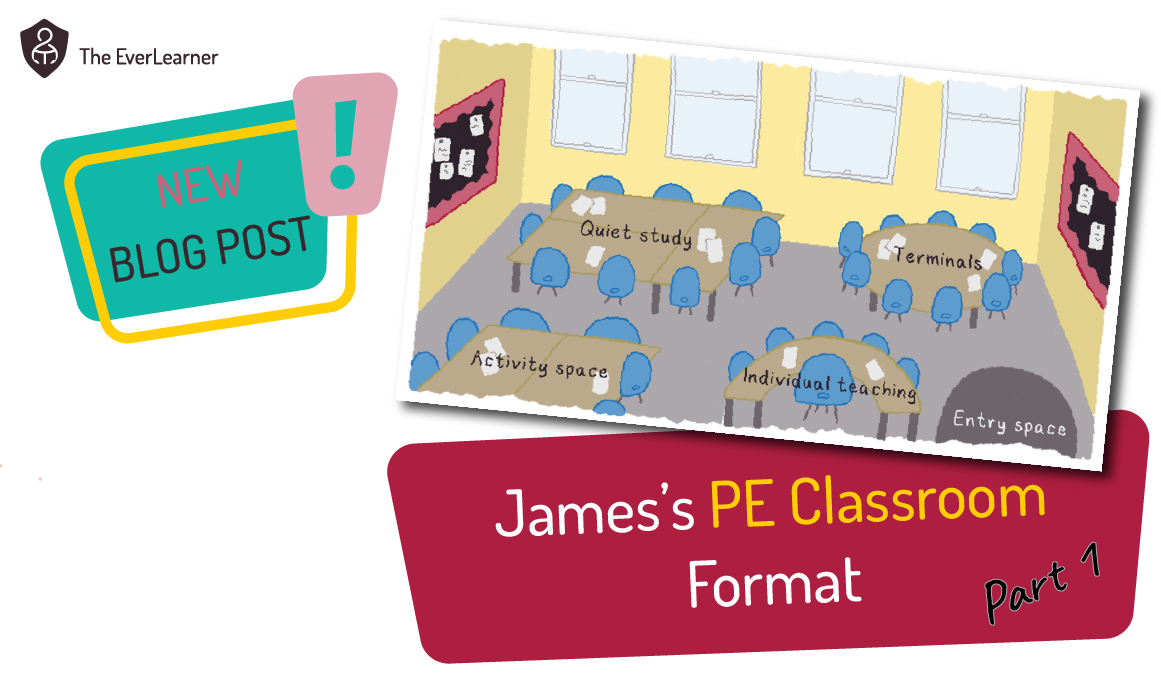What Jim told James (Conversations between an experienced Head of PE and ECT)
Foreword
This is a very worrying moment for me (and maybe you). I am about to start a blog with the words “I had a dream last night…” I have to be honest and admit that this would worry me as a reader. It would strike me as a bit of a 1980s Dallas storyline, but in this particular case, I’m going to let myself do it.
I was watching TV last night (Sunday prior to a bank holiday Monday) and I dozed off. A documentary was narrating away on Prime about crime and the legal system. Some fella had done something horrible and then tried to represent himself in court. It was awful. Anyway, I drifted off and, as I came round, I had an idea in my mind. The idea was what the 48-year-old PE teacher I am (Jim) would tell the 22-year-old PE teacher I was (James) about classroom-PE teaching if it were possible to have such a conversation. My mind drifted across numerous things I have learned and numerous assumptions I have challenged and I wondered whether I would or wouldn't tell these things to my younger self. You see, this blog is not about what ECT PE teachers should or shouldn’t know. Rather, it is about whether an experienced teacher does a service or disservice to an ECT PE teacher by telling them the whole truth. Therefore, for each of the factors that I ponder, I am going to try and decide whether I would or wouldn’t say this to the ECT version of myself. That young person, James, is, presumably, under a lot of pressure and is trying to assimilate into the industry and my experienced self needs to make a call about what and when to share certain things.
Let’s give it a try...
The post
I had a dream last night… The experienced PE teacher I am, Jim, envisioned a conversation with the young, ECT PE teacher I was (NQT back then, of course) at the start of my career in 1999. In the dream, Jim had lots of things to share with the younger self, James, and Jim had to make a decision about whether it would be facilitating or inhibiting to tell James the things that he could tell him. This post is about those decisions. Should Jim tell James the whole truth?Note: This post is specific to classroom- or qualification-based PE teaching. Whilst I have completed thousands of hours of core PE teaching, I am going to keep my observations specific to the teaching of GCSE PE, A-level PE, BTEC Sport, IB Sports, Exercise and Health Science, etc.
Subject knowledge
 James: “Agreed. Can you tell me what you consider subject knowledge to be?”
James: “Agreed. Can you tell me what you consider subject knowledge to be?”This is really important to how successful your students can be as a result of the experiences they gain in your lessons and their associated out-of-lesson time study. It is our ethical and practical duty to allow our students the possibility of achieving every point within a mark scheme. Many, many PE classrooms fall short of this, unfortunately, and it is an area in which you can mark your teaching out as better or high-quality in comparison.
Let’s take an example from OCR GCSE PE. The specification states the following for the long-term effects of training:

But the key factor here is being able to understand and apply these effects, including the use of data. Therefore, if we were to analyse every single mark scheme since 2018 for this section, we would find the following range of relevant material to teach:
If we extract this material from the mark schemes, we are able to produce a base requirement for our teaching as follows:
|
Understand the long-term effects of exercise on |
General |
Less likely to have disease |
|
Decreased chance of premature death |
||
|
Moderate intensity is best/low intensity is best |
||
|
Control amount of body fat |
||
|
Bone density |
Increased bone density |
|
|
Stronger bone matrix |
||
|
Less brittle bones |
||
|
Decreased chance of osteoporosis |
||
|
Hypertrophy of muscle |
Increase in muscle size/Increase in cross-sectional area |
|
|
Increase in strength |
||
|
Muscular strength |
Increase in strength of muscle |
|
|
Increase in muscle tone |
||
|
Increase in power |
||
|
Stronger ligaments |
||
|
Increase in tendon strength |
||
|
Muscular endurance |
Increase in muscular endurance |
|
|
Decrease in fatigue |
||
|
Go for longer |
||
|
Resistance to fatigue |
Increased resistance to fatigue |
|
|
Increased rate of removal of lactic acid |
||
|
Increased tolerance to lactic acid |
||
|
Hypertrophy of the heart |
Increased size of the heart |
|
|
The heart becomes stronger/stronger contractions |
||
|
Resting heart rate |
Decreased resting heart rate |
|
|
Bradycardia |
||
|
Resting stroke volume |
Increased resting stroke volume |
|
|
Cardiac output |
Increase in maximum cardiac output |
|
|
Rate of recovery |
Increased recovery rate |
|
|
Increased rate of removal of lactic acid |
||
|
Reduced recovery time |
||
|
Recovery will be longer if more lactic acid has built up/Lactic acid slows down recovery |
||
|
Aerobic capacity |
Increased tolerance to lactic acid |
|
|
Delayed OBLA |
||
|
Higher anaerobic threshold |
||
|
Keep playing for longer/keep playing harder/more likely to last 90 minutes |
||
|
Respiratory muscles |
Increased strength of respiratory muscles/Stronger diaphragm/Stronger intercostals |
|
|
Increased efficiency to take in oxygen |
||
|
Increased surface area of alveoli because more alveoli are reached |
||
|
Tidal volume during exercise |
Increase in tidal volume/Increase in TV/Increase in resting tidal volume |
|
|
Minute volume during exercise |
Increase in minute volume/Increase in VE |
|
|
Increase in maximum pulmonary ventilation/Increase in total amount of air into the lungs |
||
|
Capillarisation |
Increase in the number of capillaries |
|
|
Capillarisation at the muscles |
||
|
Capillarisation at the heart |
||
|
Capillarisation at the lung/Increased capillary density around alveoli |
And we also need to recognise that this is not the end of the story. We still need to be able to apply this understanding to a range of different contexts AND, where relevant, evaluate the concepts or analyse them using data.
Finally, as comprehensive as the list above may appear to you, we also need to recognise that this content requirement merely represents what has been required previously. We still need to be able to “teach for the future mark schemes” and to ensure that our learners have a knowledge base which is robust enough to be applied in unique ways in future exams.
Therefore, all in all, ‘teaching to the spec’ is simply not going to cause your students to be able to perform well in exams. For this reason, I state:
It is the core duty of a PE teacher to teach to the fullest breadth of a specification mark scheme as a minimum.
James, I also want to draw your attention to the word ‘minimum’ in the statement above. I want you to recognise that teaching to the depth and breadth that I am advocating for is not aspirational. Rather, it is the base requirement of teachers, and every PE teacher needs to achieve this. Otherwise, we are simply causing our students to lack the knowledge and skill base to access a mark scheme for our course.”
Conclusion 1
So, should Jim tell this to James? What do you think?My answer is: DEFINITELY!
In fact, I believe it would be a serious omission not to share this with James.
But there is also another crucial point to make. This aspiration needs to be supported and resourced. It is the role of Jim (experienced) to support James (inexperienced) to achieve this aspiration, rather than setting a high bar and simply judging. Accountability will occur simply by the fact that students will be externally examined. Therefore, with this level of guaranteed accountability, there needs to be guaranteed support, and this is amongst the reasons why The EverLearner’s new 2025 PE Teacher Academy will include an entire section for PE teachers called Subject Knowledge. Watch this space! You can register your interest in this brand-new course here:
Differentiation
 James: “But making sure learning is relevant to different students is important, right?”
James: “But making sure learning is relevant to different students is important, right?” James: “So, what’s the issue from your perspective?”
James: “So, what’s the issue from your perspective?” James: “Wow, okay. So, no differentiation by task, then?”
James: “Wow, okay. So, no differentiation by task, then?” James: “You mentioned differentiation by outcome, too. Does the same apply?”
James: “You mentioned differentiation by outcome, too. Does the same apply?” James: “Okay, so let’s say I don’t differentiate by task or by outcome, how do I differentiate?”
James: “Okay, so let’s say I don’t differentiate by task or by outcome, how do I differentiate?”So, let’s break these down:
| Type | What is it? | Requirements | Regularity of my usage |
| By task | Providing a different activity for learners of different levels / experience / potential |
Knowledge of a student’s current performance Knowledge of what a student has the potential to learn |
Never |
| By outcome | Providing a different expected standard of outcome for different learners |
Knowledge of a student’s current performance Knowledge of what a student has the potential to learn |
Never |
| By pace and/or repetition | Providing a fixed standard of achievement and allowing different learners different lengths of time or number of repetitions to achieve it | Knowledge of a student’s current performance | Every lesson |
| By type of scaffolding | Providing different support structures to different students in order to meet a standard | Knowledge of a student’s current performance | Every lesson |
This is what I believe and what my experiences tell me. What do you think?”
Conclusion 2
So, should Jim tell this to James? What do you think?My answer is: PROBABLY!
Although I am hyper-confident in what is written above, I have to acknowledge that approaching classrooms and education this way will put the young James at odds with almost everything around him. Therefore, I would suggest that a character like Jim should take his time on this one and allow James to figure some things out for himself, as well as guiding him to the answers.Classroom management
I am going to be so unpopular with this… Here goes… James: “What approach do you take to classroom management, Jim?”
James: “What approach do you take to classroom management, Jim?” James: “What do you mean? A lot of what I have learned and a large section of the teacher standards are about classroom management.”
James: “What do you mean? A lot of what I have learned and a large section of the teacher standards are about classroom management.” James: “But isn’t that just rewording things?”
James: “But isn’t that just rewording things?”I’ll go further, James. Look out for colleagues in the coming years who 'sell you’ a message of command and control in your classroom. I can guarantee you that these colleagues, who may well be trying their best, have never operated in a world-class classroom. They have never felt the natural and organic “control” that occurs because students are truly learning deeply. Disciplinary structures, sanctions and rewards systems and “Classroom management” are, broadly, required because world-class learning is not occurring and control needs to be achieved instead.”
 James: “But surely sometimes things go wrong and someone acts up and disrupts.”
James: “But surely sometimes things go wrong and someone acts up and disrupts.” James, what I am telling you about here is aspirational and what, perhaps, you should be aiming for over the cycle of your career. It is normal that you will need systems to begin with. Definitely! I will personally support you within those systems, but I also want to ask you to raise your head high and know, for sure, that there is a truly reliable and sustainable way of achieving classroom management and that is to provide young people with the most exciting learning experience of their lives. We must aim for that.”
Conclusion 3
So, should Jim tell this to James? What do you think?My answer is: I WOULDN’T!
Once again, I believe in what is written in this section, but I worry it would set James up to fail. This type of message needs to be displayed through behaviours and not words. Perhaps the way to do this is to show it and not say it. Perhaps this is my role in this case.
…and finally
I will leave this post here for today and, should readers be interested in this post, I will continue it with parts 2, 3, etc. I have enjoyed writing this post, although I wonder what readers will make of it. Am I being utopian? Maybe. But I have the right to write my thoughts too, and that’s what I’m doing. In my opinion, it is fair to express one’s experiences and knowledge if it has a sound base, and I am confident in what I have provided here.Thanks for reading.
James
%20Text%20(Violet).png)



